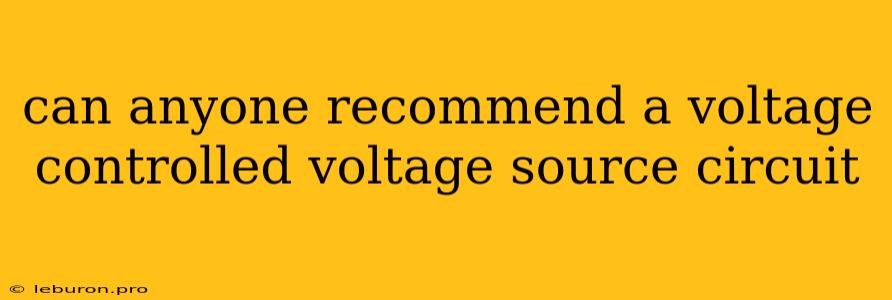The need for precise and controllable voltage sources arises in various electronic applications, from research and development to hobbyist projects. While readily available off-the-shelf solutions exist, building your own voltage controlled voltage source (VCVS) circuit can provide valuable insights into the fundamental principles of analog electronics and offer customized functionalities. This article delves into the design, functionality, and applications of VCVS circuits, offering a comprehensive guide for anyone seeking to understand and implement these versatile components.
Understanding the VCVS Circuit
A voltage controlled voltage source (VCVS) is an electronic circuit that produces an output voltage proportional to the input voltage. In essence, it amplifies the input voltage without drawing any significant current from the source. The key characteristic of a VCVS circuit is its high input impedance and low output impedance. This implies that the circuit can accurately measure the input voltage without loading the source, while simultaneously providing a stable output voltage regardless of the load connected.
Key Components of a VCVS Circuit
The most common VCVS circuit utilizes an operational amplifier (op-amp) as the core element. The op-amp, with its high open-loop gain and differential inputs, acts as an ideal voltage amplifier. Other essential components include:
- Resistors: These determine the voltage gain of the circuit, establishing the proportionality factor between input and output voltages.
- Capacitors: These are employed for filtering and frequency-dependent characteristics, allowing for control over the circuit's response to varying input signals.
Operational Principle
The VCVS circuit works based on the principle of negative feedback. The op-amp compares the output voltage to a fraction of the input voltage, creating an error signal. This error signal is then amplified and fed back to the input, driving the output voltage to match the desired level. The feedback loop ensures that the output voltage precisely tracks the input voltage, scaled by the gain factor determined by the resistors.
Designing a VCVS Circuit
Designing a VCVS circuit involves selecting appropriate op-amp and resistor values based on the desired gain, input voltage range, and output current requirements. Here's a step-by-step approach for designing a simple VCVS circuit:
- Choose an Op-Amp: Select an op-amp that meets the voltage and current requirements, considering parameters like voltage rail-to-rail operation, input bias current, and slew rate.
- Determine Gain: The voltage gain (A) of the VCVS is determined by the ratio of feedback resistor (Rf) to input resistor (Rin): A = Rf/Rin. Select appropriate resistor values based on the desired gain.
- Input Voltage Range: Ensure that the op-amp's input voltage range encompasses the expected input signal.
- Output Current: Consider the op-amp's maximum output current and the load requirements. For high-current applications, additional power amplifiers might be necessary.
Applications of VCVS Circuits
VCVS circuits find diverse applications in various fields, including:
- Signal Amplification: VCVS circuits are widely used in audio amplifiers, instrumentation amplifiers, and other applications requiring voltage gain without loading the input source.
- Voltage Level Shifting: They can shift the voltage level of a signal, enabling compatibility between different circuits with varying operating voltage ranges.
- Active Filters: VCVS circuits can be incorporated into active filter designs for signal conditioning and noise reduction.
- Voltage References: VCVS circuits can be configured as voltage references, providing stable and accurate reference voltages for various applications.
- Instrumentation: VCVS circuits are used in measurement systems for signal scaling and amplification, enabling precise readings of various physical parameters.
Advantages and Disadvantages of VCVS Circuits
VCVS circuits offer several advantages:
- High Input Impedance: They minimize loading effects on the input source, ensuring accurate signal measurement.
- Low Output Impedance: They provide stable output voltage even with varying loads.
- High Gain: VCVS circuits can amplify signals by significant factors, providing signal strength and flexibility.
- Versatility: They can be configured for various functions, including amplification, level shifting, and filtering.
However, VCVS circuits also have certain disadvantages:
- Limited Bandwidth: The bandwidth of VCVS circuits can be limited due to the op-amp's slew rate and internal capacitances.
- Output Voltage Swing: The output voltage of a VCVS circuit is limited by the op-amp's power supply rails.
- Noise and Distortion: VCVS circuits can introduce noise and distortion, particularly at high frequencies or with low-quality op-amps.
Conclusion
VCVS circuits are fundamental building blocks in analog electronics, offering versatile capabilities for signal amplification, voltage level shifting, and other functions. Understanding the design principles and applications of VCVS circuits empowers individuals and professionals to leverage these circuits in diverse projects, from hobbyist endeavors to professional applications. By carefully selecting op-amps and resistors, and considering the limitations of these circuits, users can effectively utilize VCVS circuits to create innovative and effective solutions for various electronic needs.
